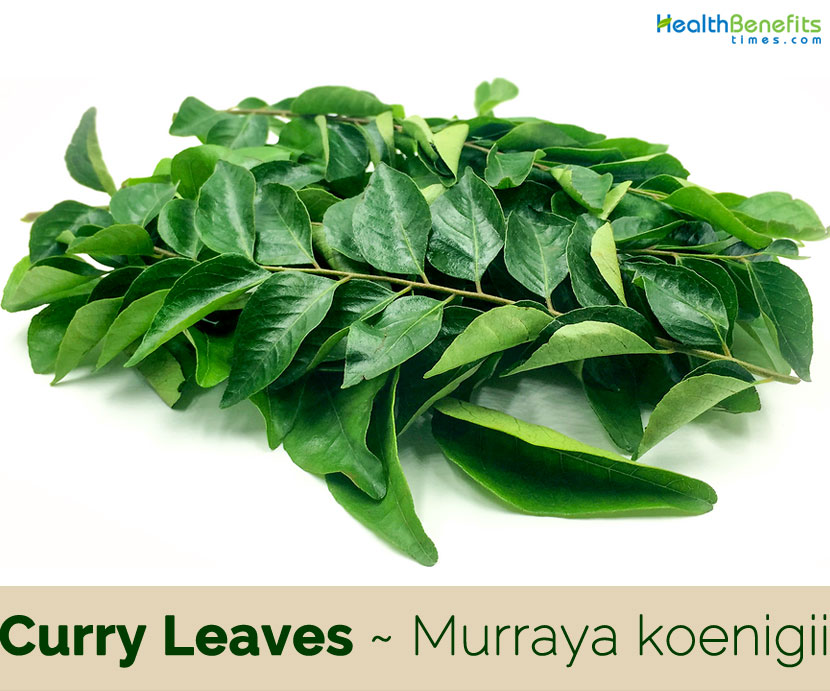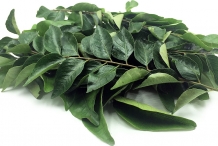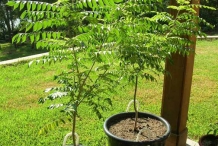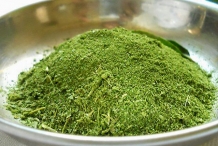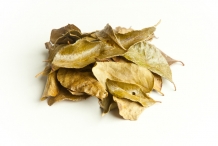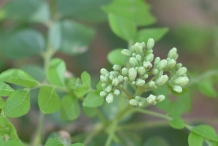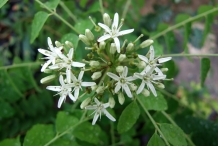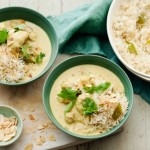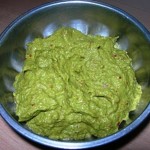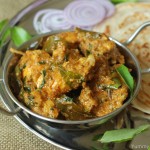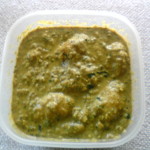| Curry leaves Quick Facts | |
|---|---|
| Name: | Curry leaves |
| Scientific Name: | Murraya koenigii |
| Origin | Pakistan, Sri Lanka and India east to China and Hainan |
| Colors | Green when young turning to purplish black when ripe |
| Shapes | Ovoid to oblong, glandular berry, 1–1.5 cm × 1 cm, bluish black |
| Taste | Slightly pungent and bitter |
| Health benefits | Stops Diarrhea, Fights Cancer, Kidney Problem, Lowers Cholesterol Levels, Accelerates hair growth, Eye Disorder, Reduces congestion in the chest, Treats skin infections, Cure anaemia, Cures heart disease, Relieves the symptoms of diarrhoea, Control bile, Constipation, Nausea, Alleviates burn wounds, weight loss and Controls hair fall |
| Name | Curry leaves |
|---|---|
| Scientific Name | Murraya koenigii |
| Native | Pakistan, Sri Lanka and India east to China and Hainan. It has been widely cultivated in South-East Asia and some parts of the United States and Australia. In tropical Africa it is planted in many countries, including Nigeria, Kenya, Tanzania and most of the Indian Ocean Islands |
| Common Names | Curry leaves, Curry leaf tree, Sweet nim, currybush, Indian bay |
| Name in Other Languages | Arabic: Warak al kari Assamese: Bishahari, Narasingha, Narasihgha, Nor hing, Narasinha pāta (নৰসিংহ পাত) Noroximh pat, Noroxingho pat Bengali: Barsunga, Barsanga, Kariaphulli, Kārigācha (কারিগাছ) Kari gaas, Karipata (কারিপাতা), Bārasuṅgā (বারসুঙ্গা) Bulgatian: Lista ot kŭri (Листа от къри) Burmese: Kyaung-thwe, Pyim daw thein Cambodia: Xantroc Catalan: Arbre de fulla de curri Chinese: Ma jiao ye, Ka li cai (Ga li cai), Ga li ye, Ga li ye Czech: Karí lístky Danish: Karry blad Divehi: Hikandifat ( ހިކަނދިފަތް) Dutch: Kerriebladeren, Kerrieboom English: Curry leaves, Curry leaf tree, Sweet nim, currybush, Indian bay Estonian: Karrilehed Finnish: Currylehdet, Intianjasmikki French: Arbre à curry , Arbre à feuilles de curry, Calou pilé, Kalou pilé, Carripoulé, carri poulet, faripoulé, feuilles de curry German: Curryblätter, Curry-Orangenraute, Currybaum Greek: Mourraiḯa tou Kénink (Μουρραιΐα του Κένιγκ) Gujarati: Mitha limbdo, Mitho limado (મીઠો લીમડો), karuveppilai, sweet neem, kadi patta, kadhi limbdo Hebrew: Ali kari (עֱלֵי קָרִי), קארי Hindi: Gandhel (गन्धेल ), Kadhipatta (कढी पत्ता), Kadipatha , Karipatta (करीपत्ता), Meetha neem (मीथ णीम), Meetha neem patta (मीथ नीम पत्ता), Mithinim (मीठीनीम), kadhee patte ka ped (कढ़ी पत्ते का पेड़) , Katnim, Kitha neem, barsanga, bursunga, gadhelu, gadhelu/gandla, gandela, gandhela, gandhla, gandla, gani, ganuhilu, harri, kathnim, katnim, kudia-nim, karaypak Icelandic: Karrílauf Indonesian: Salam koja Irula: Kuruveppilai Italian: Fogli di Cari Japanese: Nanyou zanshou (ナンヨウザンショウ), Oobagekkitsu (オオバゲッキツ) Kannada: Karibevu (ಕರಿ ಬೇವು), , ಕರಿಬೇವು ಸೊಪ್ಪು (Karibevu soppu), Karibēvina mara (ಕರಿಬೇವಿನ ಮರ), besoppu, gandha baevu, gandha bevu, gandhabevu, kakibevu, karabeaevu, karbaevu, karepak, kari-bevinagida, karibaevina mara, karibaevu, karibevana, karivebu, oggarane yele mara Karbi: Thenhskso Khmer: Xantroc Korean: Keoli lipeu (커리 리프 ) Ko ri ri pu Laotian: Dok kibi, Khi be Lithuanian: Karis, Kvapioji murėja Malay: Daun kari pla, Daun kari, Garupillai, Karupillam, Karwa pale, Kerupulai, Pokok Kari Malayalam: Kareapela, Karivepp (കറിവേപ്പ്), Kariveppila (കറിവേപ്പില), Kariveppalai, Veppila (വേപ്പില), karepak, kari-bepau, karibepou, kariveppu, karivepu, kariyapala, karrayapela, karu-veppa, karuvepilai, karuveppu, maricangam, mirsingam, karivaepu Marathi: Jhiranga (झिरंग), Kadhinimb (कढीनिंब), Karhilimb , Kudianim, gandha, gandla, godanimb, jhirang, jirani, kadhi-nim, kadhianimba, kadi-nimb, kadiben, karepacha, karhinimb, karipat, kudianim, puspala, kadhee-nimba Mizo: Arpatil Myanmar: Kyaung-thwe Nepali: Meciyaa saag (मेचिया साग), Mitho Neem (मिठो नीम), Neem Kauree (नीम कौरी), Bauguretee (बौगुरेती), Bogaaino (बोगाइनो), Bookinee (बोकिनी) Norwegian: Karriblader Oriya: Bhersunga, Lesunadando, Merisinga patra (ମେରିସିଙ୍ଗା ପତ୍ର), bhr̥saṅga gacha (ଭୃସଙ୍ଗ ଗଛ) Persian: درخت کاری Portuguese: Folhas de Caril Punjabi: Gandalu (ਗਾਂਦਲੂ), Gandla (ਗੰਦਲਾ), Karipata (ਕਰੀਪਤਾ ), Karhi pata da rukha (ਕੜ੍ਹੀ ਪੱਤੇ ਦਾ ਰੁੱਖ) Russian: List’a karri (Листья карри), Муррайя Кёнига (Муррайя Кёнига) Sanskrit: Alakavhayah (अलकाह्ययः), Girinimba, Kalasaka, Mahanimba, Surabhinimba, Suravi, Chhardighna, Kadarya, alakavhaya, chhardighna, kaidarya, kaidaryah, kaitarya, kalasakah, krishnanimba, krishnapatabhinimba, kristnanimba, maharishta, nimba-patram, nimba-vrkshaha, nimbapatra, priyasala, raman, shuklasara, surabhi, surabhi-nimbu, varatikta, kristnanimbao, krshn nimb patr (कृष्णनिम्बपत्रम्) Sinhalese: Karapincha (කරපිංචා) Slovekian: Karí list Slovenian: Curry listi Spanish: Hoja, Hojas de Curry Swahili: Bizari, Mchuzi Swedish: Currybladsbuske Tagalog: Bignay Tamil: Kari vempu (கறிவேம்பு), Kariya nimpam (கரியநிம்பம்), Kariveppallai, Karivepillai (கரிவேப்பிலை), Kariveppilai, Karuvepila, Karuvapilai, Karu veppilai (கருவேப்பிலை), Karuveppillai (கறூவேப்பிலை), enneykkarai , karivembu, karivempu, kariveppilaimaram, kariyapilai, kariyapilai, karu-vembu, karu-veppilai, karupalai, karuppilai, karuvembu, karuvempu, karuveppu, kattuveppilai, kattuveppilai, nattukkariveppilai, uluvavikacceti, uluvavikam, karaway pillay, kariyapilai Telegu: Karepeku, Karivepachettu (కరివేపచెట్టు), Karivepaku (కరివెపాకు), Kariveppaku, kaliama, karempaku, karepak, karepaku, karevepa, karimpaku, karivapaku, karivempu, karivemu, karivepa, karivepamu, karrivaympakoo, karsepak, karuvepaku, karivaepamu Thai: Hom khaek (หอม แขก), Smad (สมัด), Som (โสม), H̄mx n̂xy (หมอ น้อย) Mo noi Turkish: Köri yaprağı Ukrainian: Listi karri (Листи каррі) Urdu: Kariapat (کریاپات) Kari patah (کری پتہ ) Vietnamese: Cari, Lá cà ri, Cơm nguội, Ngệt quới koenig |
| Plant Growth Habit | Small, tropical to sub-tropical tree or shrub |
| Growing Climates | Plain areas, along roads, railway lines, undergrowth or among bushes and hedges |
| Soil | Grows best in deep, well-drained soil |
| Plant Size | 4–6 m (13–20 feet) tall, with a trunk up to 40 cm (16 in) diameter |
| Stem | Brown to dark green in color, with dots on the bark like small node on it |
| Leaf | Aromatic leaves are pinnate, with 11–21 leaflets, each leaflet 2–4 cm (0.79–1.57 in) long and 1–2 cm (0.39–0.79 in) broad |
| Flowering season | April-May |
| Flower | Small white, bisexual, regular, 5-merous, aromatic. pedicel short, calyx with tiny ovate teeth; petals oblanceolate to oblong, 5–7 mm long, glandular, white; stamens 10, ovary superior, stigma capitate |
| Fruit Shape & Size | Ovoid to oblong, glandular berry, 1–1.5 cm × 1 cm, bluish black, containing 1 or 2, large viable seed |
| Fruit Color | Green when young turning to purplish black when ripe |
| Flavor/Aroma | Aromatic |
| Taste | Slightly pungent and bitter |
| Plant Parts Used | Leaves |
| Season | July-August |
| Health Benefits |
|
Plant description
Curry leaves is a semi deciduous, unarmed aromatic small spreading, tropical to sub-tropical shrub or tree with strong woody stem but slender with the stem which is dark green to brownish in color. Normally the plant grows about 4–6 m (13–20 feet) tall, with a trunk up to 40 cm (16 in) diameter. The plant is found growing in plain areas, along roads, railway lines, and undergrowth or among bushes and hedges. It grows best in deep, well-drained soil. The stem of Curry tree is brown to dark green in color, with dots on the bark like small node on it, when the bark was peeled off longitudinally under the exposing the white wood underneath; the girth of the main stem is 16 cm and up to 6 meters in height and 15 to 40 cm in diameter.
Leaves
Curry leaves are aromatic in nature having characteristic aroma, leaves of curry leaves are shiny and smooth with paler undersides. Leaves are pinnate, exstipulate, having reticulate venation and having ovate lanceolate with an oblique base, with 11-21 leaflets whose size description is each leaflet is 0.79–1.57 inch long and 0.39–0.79 inch broad. Leaflets are short stalked, alternate, gland dotted and having 0.5-cm-long petiole. The leaf margins are irregularly serrate. The yield of a bush in approximately found about 480 g in three to four pickings.
Flower
Flowers of curry leaves is small, white fragrant and funnel- shaped, regular, pentamerous, stalked, complete, ebracteate, hypogynous, persistent, inferior, green, corolla, polypetalous, androecium, polyandrous, lanceolate, stigma, bright, sticky, style, short, ovary, inflorescence, a terminal cyme, the diameter of a flower is 1.12 cm in the fully opened form, each cluster bear approximately 60 to 90 flowers at a time after flowering at once, 5-lobed calyx, with petals in having length 5 mm and the petals are 5 in number, with stamen in number 10 and in small in size approximate number 4 mm, dorsifixed, arranged into circles, with long superior gynoecium with size 5 to 6 mm. Curry tree flowers have a sweet fragrance, bisexual and are self-pollinated. Flowering normally takes place from April-May.
Fruits
Fruits of the Curry tree occur in cluster form vary in 32 to 80 in number. The fruits are in the ovoid or sub-globose and small in size in the spinach green color seed in one or two number which are enclosing each other in thin pericarp. The fruits are 1 to 1.2 cm in the diameter with length 1.4 to 1.6 cm, purple black after ripening and they are edible and yields 0.76% of a yellow volatile oil. Curry leaf fruit is 11 mm long and weigh about 445 mg Fruits. The plant produces small white flowers which can self-pollinate. The weight of pulp is 880 mg and the volume is 895 micro liters. The seeds are poisonous in nature and should not be consumed for any purpose.
Health Benefits of Curry Leaves
Many people believe that curry leaves simply add flavor on the food plus they throw the leaves away whilst consuming their soup or curry. However, curry leaves are much more essential compared to lots of people realize, plus they provide a number of health advantages with no negative effects of other medications.
1. Stops Diarrhea
Scientific studies carried out by Ashish Pagariya as well as Maithili, V. determined that the carbazole alkaloids contained in curry leaves or even Murraya Koenigii had anti-diarrheal qualities. Experiments on lab rats demonstrated that carbazole extracts from curry leaves had considerably managed castor oil-induced diarrhea. A number of curry leaves could be ground up and also the paste could be eaten or even the juice of the leaves could be consumed.
2. Gastrointestinal Protection
Usage of curry leaves is usually recommended as a treatment for gastrointestinal issues in Ayurvedic methodology. One important is because of the fact that they’re thought to have got moderate laxative qualities. Make juice from a lot of curry leaves as well as add lime juice. This mix is to be consumed for indigestion or perhaps a paste made out of the leaves could be included with buttermilk and taken every day before eating anything.
3. Antioxidant Properties
Research studies carried out by Mylarappa B. Ningappa et al. at Jawaharlal Nehru Center for Advanced Scientific Research, Molecular Parasitology and Protein Engineering Laboratory in Bengaluru, India have revealed that curry leaves or Murraya Koenigii is a great source of antioxidants. The existence of numerous vitamins just like vitamin A, B, C and E assist in decreasing oxidative stress and free radical scavenging activity. Curry leaves could be included with your curries, vegetable stews as well as soups. They’re also obtainable in dried powder form.
4. Anti-Diabetic Properties
Perhaps one of the largest health advantages of curry leaves is its used in diabetes control. Research carried out by the Department of Biochemistry as well as Molecular Biology at University of Madras, Chennai had proven that the anti-hyperglycemic qualities of curry leaves were valuable in managing blood sugar levels in diabetic rats.
5. Fights Cancer
The chemical constituents present in curry leaves like phenols are beneficial in eliminating cancers like leukemia, prostate cancer as well as colorectal cancers. Research on curry leaves at the Department of Medical Chemistry at Mejio University, Japan showed proof of cancer fighting qualities within the carbazole alkaloids extract from curry leaves.
6. Kidney Problem
Curry leaves health benefits also have rest from kidney pain, treatments for minor superficial skin injuries, as well as managing diabetes. The bark and root of the curry leaves plant is considered to hold therapeutic qualities as some herbalists declare that the powdered form of the bark as well as root can be used as a number of problems which includes dealing with diabetes; however further research is required to verify these types of claims and therefore diabetes patients mustn’t rely exclusively on curry leaves like a form of treatment. Curry leaf health advantages include reliving associated with the kidneys. Bilious vomiting could be controlled with the aid of the bark of the curry leaves tree. Try taking some dry bark and make a decoction along with cold water and provide this to the patient for convenient relief.
7. Lowers Cholesterol Levels
Curry leaves are commonly known as to lessen bad LDL cholesterol level. Studies carried out in the Department of Biochemistry at the University of Kerala, India have demostrated that curry leaves have the possibility to lessen LDL cholesterol levels.
8. Accelerates hair growth
Kadi patta has always been recognized to avoid greying of the hair because of the existence of various nutrition within the body. Additionally it is extremely effective for treating damaged hair, including bounce to limp hair, strengthening the shaft of thin hair, hair loss as well as treats dandruff. The best part relating to this benefit is that you can possibly decide to eat the curry leaves to help together with your hair woes or even apply it to your scalp like a remedy.
9. Protects your liver from damage
If you’re a heavy drinker, consume a lot of fish or even enjoy other activities that may be damaging your liver, then you definitely must consume curry leaves. It is because, in accordance with a survey published in AsianJournal of Pharmaceutical and Clinical Research[1], curry leaves were protect your liver from oxidative stress and harmful toxins that build-up within your body because of the existence of kaempferol, a powerful antioxidant. The impressive anti-oxidative property whenever coupled with vitamin A as well as C not just safeguards the liver but energizes the organ to work more proficiently.
10. Eye Disorder
The fresh juice of curry leaves are also utilized as an eye treatment for particular eye problems, particularly in arresting the development of cataract. Traditional practitioners suffuse the fresh extract of curry leaves within the eyes of patients who are suffering from bad eyesight therefore helping them to avoid early growth and development of eye problems. The fruit of the curry leaves tree are viewed to be delicious and in addition have got therapeutic qualities whenever utilized as an external application for insect bites as well as stings of poisonous creatures. The juice of the fruits is combined with an identical amount of lemon juice and is also utilized to apply on the bites for immediate and speedy relief.
11. Reduces congestion in the chest and nose
If you suffer a wet cough, sinusitis or even chest congestion, curry leaves is an extremely efficient home cure to cure the signs and symptoms. Full of vitamin C, A and compounds like kaempferol which is a very powerful anti-inflammatory, decongestant and antioxidative agent, curry leaves might help loosen up as well as release congested mucous.
12. Can reduce the side effects of chemotherapy
In accordance with research, curry leaves have the incredible capability to safeguard the body from the ill effects of chemotherapy as well as radiotherapy. It not just safeguards the chromosomes from damage but additionally safeguards the bone marrow and halts the creation of free-radicals within the body. The research also recommended that this amazing ability of the leaf may also indicate the capability to safeguard the body from cancer.
13. Protects Against Pathogen Attack
Research on curry leaves has said that they’re also great at combating bacterial as well as fungal infections. The leaf extracts from the plant have already been similar to popular, mainstream antibiotic medications.
14. Pregnancy
Pregnant women happen to be utilizing curry leaves to lessen the soreness of morning sickness. This problem is generally observed in the first trimester of pregnancy. The changes in the pregnant woman’s hormones result in nausea that could result in vomiting. A boiled essence of the bark is utilized to manage nausea and stop extreme vomiting. Gnawing on fresh curry leaves is additionally very theraputic for nausea, although the taste might be somewhat bitter. Since there are no curry leaves side effects, this cure for morning sickness remains safe both for mother and child. A chemical research into the leaves demonstrates they include over 60 % moisture. The rest is made from a combination of carbohydrates, fiber, minerals, and vitamins. A number of these are straight liable for the health advantages you experience.
15. Protects the Liver
Your liver performs a significant role within the digestive system also it must be protected against any attack by free-radicals, in addition to viral and also bacterial attacks that may result in infection. Research on curry leaves has established that the tannins and carbazole alkaloids contained in curry leaves displayed good hepato-protective properties. They’re also useful in safeguarding the liver from numerous diseases like hepatitis and cirrhosis.
16. Treats and prevents skin infections
Sounds amazing, doesn’t it? Yet it’s true. curry leaves consists of quite strong antioxidant properties along with effective anti-bacterial, anti-fungal as well as antiprotozoal qualities. This will make it an excellent home cure to cope with typical skin ailment just like acne and fungal infections of the nail which are frequently hard to treat.
17. Helps keep anaemia at bay
curry leaves are a rich source of iron as well as folic acid. Curiously, anaemia isn’t just regarding the insufficient iron within your body but additionally in regards to the body’s inability to soak up iron and utilize it. This is where folic acid comes into play. Folic acid is primarily liable for iron absorption and since curry leaves is a rich source of both the compounds it’s your one-stop natural remedy to get over anaemia. Here is how eating beetroot might help fight anemia.
18. Protects you from heart disease
Did you know that curry leaves have got properties that will help in reducing one’s blood cholesterol levels? Well, according to a report published in the Journal of Chinese Medicine, curry leaves avoid the oxidation of cholesterol since it is full of anti-oxidants. Thus boosts the amount of good cholesterol (HDL) as well as safeguards you from heart disease as well as atherosclerosis.
19. Relieves the symptoms of diarrhoea
Although curry leaves have got mild laxative qualities, it is just a wonderful cure for diarrhoea. It is because curry leaves consists of carbazole alkaloid which posses anti-bacterial as well as anti-inflammatory qualities which often assist in fighting an upset stomach. Aside from that, curry leaves are commonly known as to balance all of the three doshas within the body and lower the amount of pitta within the stomach – an unwanted effect of diarrhoea in accordance with Ayurveda.
20. Controlling bile
Since curry plant is really a therapeutic herb, aside from its leaves, other different parts of it also have some extremely effective therapeutic qualities. The bark of curry tree offers rest from problem just like indigestion, diabetes along with other stomach problems. If you’re struggling with bilious vomiting, curry leaves could be a fantastic cure. You are able to dip a few curry leaves and bark in hot water and keep for a while. After an hour, take out the bark and leaves and drink the water to get solution of bilious vomiting.
21. Constipation
Curry leaves have got a natural mild laxative effect. To relief constipation, soak curry leaves in warm water for just two hours and drink the water using a teaspoon of honey at the beginning of the morning. It can help to cleanse the system as well as enhance your appetite. On the other hand, fresh curry leaves juice may also be combined with buttermilk. This mix could be consumed 3 times in one day for efficient outcomes.
22. Nausea
To manage morning sickness, particularly while pregnant, you are able to make a decoction along with one tsp curry leaves juice, one tbsp lime juice and one tsp honey. Ideally consume it at the start of the morning. Another simple option is to include few curry leaves whilst brewing tea.
23. Provides relief from insect bites
The fruit from the curry leaves tree are purplish berries. The juice from these berries combined with lime juice, forms an acidic and efficient solution for external rest from insect bites and stings.
24. Alleviates burn wounds
Therapeutic herbal treatments of curry leaves paste likewise incorporate successfully treating burn wounds as well as skin eruptions. It is also utilized as a covering for healing wounds.
25. Curry leaves for weight loss
Many of you’ll be surprised that curry leaf works well for weight reduction. But like most of the herbs, it manages the digestive system, if consumed frequently. A good functioning of digestive system is the key to effortless weight reduction naturally.
26. Helps in repairing hair root
If you use shampoos along with other hair products that consist of a lot of chemicals in your hair, the roots of the hair get affected and results in damage to the hair. Usage of numerous heating tools and also the pollution and dust within the environment also result in the damage of hair roots. Curry leaves are full of essential oils which help in repairing the damaged hair roots. Create a smooth paste of curry leaves by grinding all of them with a little of water. Use this particular well in your scalp and hair. This could repair the roots as well as rejuvenate them. In case you use this particular paste of curry leaves frequently, it can make the hair follicles strong and results in boost in hair growth. You may also consume curry leaves. However it has a bitter taste and many find it difficult to consume. In case you have no problem with its taste, you are able to consume it. When you’ve got damaged hair, curry leaves behave as first aid to your hair and make the roots powerful. Once the roots are made powerful, the hair growth is additionally increased.
27. Controls excessive hair fall
Hair fall might be caused because of numerous factors. One of many causes for hair fall is insufficient proteins. Curry leaves consist of protein as well as beta-carotene in higher quantities. These may decrease hair fall while increasing the rate of growth of the hair. So, if you would like your hair to develop healthy and strong, among the simplest ways is to eat curry leaves frequently. These types of leaves are additionally rich sources of anti-oxidants. Curry leaves assist in keeping the scalp well moisturized as well as hydrated and thus makes you hair smooth as well as glowing. By keeping the hair moisturized, it will help in avoiding dandruff brought on because of drying of scalp. It’s also great for eliminating dead scalp follicles.
Health benefits of curry leaves for babies:
Here are a few of the health advantages given by curry leaves for the baby.
1. High supply of vitamins and minerals
Just like numerous leafy veggies and herbs, curry leaves are additionally a great source of numerous minerals and vitamins. These include vitamin C, vitamin A, folic acid, niacin, thiamin and riboflavin. Each one of these vitamins performs a crucial role within your baby’s development. Vitamin C is wonderful for strengthening the immune system. Niacin is wonderful for your baby’s brain development. Thiamin is known to have a role in organ and also nervous system development, etc. Curry leaves are great source of calcium. For each 100 g, curry leaves include about 830 mg of calcium. As you may know, calcium is wonderful for bone development in babies. Another essential mineral present in curry leaves is iron. About 1 mg of iron is found for each 100 g of curry leaves. Iron eliminates anemia and helps in producing hemoglobin.
2. Supply of antioxidants
Other than minerals and vitamins, research has shown that curry leaves consist of anti-oxidants that are beneficial towards free radical damage as well as oxidative stress within the body.
3. Very good for eyesight
Curry leaves are loaded with vitamin A that is excellent for eye-sight. Just like carrot is a champion of vitamin A so far as vegetables are involved, curry leaves are the champions of vitamin A whenever herbs are taken into consideration. Vitamin A is extremely great at the appropriate growth and development of eyesight in kids. Vitamin A insufficiency may cause several diseases, many of which concern the eyes.
4. Effective against gastro-intestinal disorders
Curry leaves are also great for gastrointestinal problems. They are able to decrease indigestion, nausea, stomach upsets, etc.
5. Diarrhea and dysentery
A paste of curry leaves could be prepared from diseases just like diarrhea and dysentery. These types of diseases frequently affect toddlers and infants. You are able to provide curry leaves like a complimentary medicine aside from the normal prescribed medication provided by the pediatrician.
6. Liver protection
Though liver is proven to be among the resilient organs within the body, the liver of the infant can still be susceptible to diseases. A few diseases like jaundice or even hepatitis may cause liver damage. In addition to the prescription medication, you can include curry leaves paste within your baby’s food to enhance the liver condition. Reports say that curry leaves are great for liver protection.
7. Neuro-protective properties
Aside from these benefits, curry leaves are also useful in extending neuro protection. A few research has shown that the biochemical extracts from curry leaves offer considerable neuro-protective qualities.
8. Building the immune system
Another benefit of curry leaves is its support to the immune system. Immune system of the infant may still be underdeveloped and therefore might not be sufficiently strong to combat disease leading to bacteria and viruses. Curry leaf extracts demonstrate that they could help the immune system as well as enhance it.
Handy ways to use curry leaves in meals
- Make curry leaf powder to last you for around 2 weeks. Wash as well as dry curry leaves and also let their water content totally decrease by drying them under the sun or keeping them within the refrigerator for several days. Then grind as well as store in the air-tight container. Make use of this to instantly spice your buttermilk, yogurt, salads and curries.
- Always include a few curry leaves in your lentil and rice dishes to improve the intake of this healthy food.
- Use curry leaves whenever you help make your chutneys. They go well along with coconut, coriander and mint.
- Grow a curry tree within your garden for easy accessibility to fresh curry leaves for each meal.
- Chew a few curry leaves every day to enhance digestive health and to lose weight.
Ayurvedic health benefits of curry leaves
- Grind curry leaves into a paste and blend along with turmeric and yogurt. Use on skin for getting rid of rashes, irritations and also to improve skin texture.
- Add a few curry leaves to coconut oil as well as apply on hair. Frequent use will increase the quality of the hair.
- Apply a paste of curry leaves mix along with lemon juice for strengthening hair roots.
- Intake of juice obtained from curry leaves brightens the eyes as well as delays cataract.
- Dry a few curry leaves in shade for 4-5 days. Take one teaspoon of the dried curry leaf powder and blend a teaspoon of honey within it. Consume this particular home medication for around 2 to 3 times each day to eliminate constipation.
- Drinking the juice of 15-20 curry leaves combined with a teaspoon of honey can serve as an effective curry leaf home cure for diarrhea.
- Simply consuming about 8 to 10 fresh raw curry leaves benefits in healing dysentery in your own home.
- In the morning, pregnant women struggling with morning sickness may take juice of 15-20 curry leaves, combined with one teaspoon of sugar and two teaspoons of lemon juice.
- Having buttermilk combined with a paste prepared from freshly chopped curry leaves offers rest from nausea and vomiting. Besides, you are able to soak a few curry leaves in four cups of water for just two hours, filter the solution and drink half a cupful of the infusion 3 times in one day.
- Drinking a cupful of water combined with one tablespoon of roasted curry leaves may serve as probably the most efficient curry leaf home cures for nausea.
- Taking a mix of juice obtained from curry, coriander as well as mint leaves is effective in reducing indigestion.
- Applying a poultice of curry leaves on the affected area assists heal burns as well as bruises.
- Applying a combination of pulp of berries from curry leaf tree as well as equivalent quantity of lime juice is advantageous in healing insect bites.
- When coping with issues just like appetite loss as well as tastelessness, have a therapeutic drink made by adding curry leaf paste, cumin seed powder, as well as black salt in the cup of buttermilk.
- Take a number of curry leaves and boil them in one tablespoon of coconut oil till they become dark in colors. Make use of this mixture in your hair and wash it off with herbal shampoo right after an hour to avoid and cure premature greying of hair. Additionally, it encourages hair growth. Moreover, drink juice of curry leaves every day.
- Mix equal amount of dried curry leaves, lime peel, shikakai, fenugreek seeds as well as green gram. Mash finely. Store and make use of as an alternative for soap or shampoo.
- Apply curry leaves as poultices on burns.
- To control blood pressure level, drink a glass of the juice of curry leaves 3 times a day on an empty stomach (after a month, only once a day). To get the juice, fill mixer along with washed curry leaves, add 3/4 glass water. Churn well as well as sieve. To this liquid, add some juice of a lemon and also drink fresh.
- Take fresh curry leaves and make a fine paste of them, now mix this particular paste along with yogurt equally and gently massage it on your hair and scalp. Keep this paste in your hair for 30 minutes and after that rinse well utilizing mild shampoo. By using mask once per week shows instant outcomes. This particular mask is effective for hair growth as well as makes the hair smooth, shiny simply by rejuvenating them.
- Grind tender curry leaves into a smooth paste together with little boiled milk to a smooth paste and apply this hair pack and wait for 15 to 20 minutes just before washing it off. This particular hair pack also helps prevent dandruff.
- A paste manufactured by grinding organic turmeric together with little fresh curry leaves, whenever applied to problem areas is a great home remedy for acne. But be sure to make use of pesticide free curry leaves as well as organic turmeric.
- A mix of curry leaf powder, multani mitti powder, rose water as well as few drops of rose essential oil makes an incredible face mask that stops fine lines as well as brightens the face instantly.
- Fry cumin seeds in the little bit of ghee and then the curry leaves, add a cup of water and 1/2 tsp of dry ginger powder. Allow it to simmer for some minutes, strain and cool. This mix, if taken once provides good rest from indigestion.
- For loss of appetite as well as tastelessness, have got a remedial drink made by adding curry leaf paste, cumin seed powder, and black salt in the cup of buttermilk.
- Make a paste of curry leaves along with ginger, fried black gram, and salt. This particular paste is taken along with food for a few days. This is extremely efficient at dealing with nausea and vomiting because of extreme pitta.
- Boil 1 kg of the cooking oil with 15-20 curry leaves and after that filter. This particular oil may then be utilized in preparing food stuff. This really is believed to reduce cholesterol level in oils.
- Just take 10-12 curry leaf, little tamarind and grind well. Add this to one glass water also it use daily. This will assist to prevent skin illnesses.
- The mix of curry leaf as well as turmeric utilize it every day for just one month. It may also help to prevent allergy.
- Chew a few leaves every single day to shed weight.
- A paste made from curry leaves is used on prolonged boils for convenient relief.
Buying curry leaves
Curry leaves are frequently obtainable in Indian or even Asian markets. Select fresh shiny leaves that demonstrate no signs and symptoms of yellowing or even wilting. Dried curry leaves are available too yet have a much lower taste..
Storing curry leaves
Fresh curry leaves along with stalks, kept in zip lock bags could be refrigerated for couple of days. Max: 5 days
Fresh curry leaves along with stalks removed, wiped clean could be kept in air-tight freezer friendly box for approximately 2 months or even little longer. There’s one little disadvantage… don’t put them out for a long period as discoloration begins within just few minutes of keeping them in room temperature. Preferable to use directly from freezer to pan, makes them taste exactly like fresh curry leaves. This method is extremely beneficial and is also economical, time effective (saves frequent trips to Indian stores) and taste effective (Quite not the exact match for fresh leaves but a minimum of shares that mild flavoring)
Fresh curry leaves along with stalks removed, wiped clean, lightly dry toasted and dried for few days can lead to dry curry leaves. Very mild in flavor and stays great for Six months if kept in air-tight box. An additional way to store is always to create a powder of these toasted leaves.
Clean fresh curry leaves, pat dry and ensure all water content is totally wiped off. Spread them over a paper towel and microwave for 1 minute (1000 watts) and after that cool them totally. Store them in air-tight bottle which may stay good for couple of months.
Healthy Recipes of Curry Leaves
1.Almond chicken curry with curry leaf and toasted coconut basmati rice
Ingredients
- 3/4 cup (90 g) almond meal
- 1 cup (250 ml) water
- 1 tbs ghee
- 2 brown onions, cut into wedges
- 2 tsp finely grated fresh ginger
- 2 tsp ground cumin
- 1 tsp ground coriander
- 1 tsp ground turmeric
- 1/2 tsp ground cinnamon
- 1/2 tsp ground cardamom
- 8 (about 800 g) chicken thigh fillets, halved
- 2 tsp garam masala
- 1/2 cup (125 ml) cream
- Toasted flaked almonds and coriander leaves, to serve
Curry leaf and coconut rice
- 1/2 cup (40 g) shredded coconut
- 1 tbs ghee
- 12 curry leaves
- 1 cup (200 g) basmati rice
- 1 1/2 cups (375 ml) salt-reduced chicken stock
Directions
- Combine the almond meal as well as water in medium bowl. Set aside for 1 hour to soak.
- Heat the ghee in the large saucepan over medium heat. Add some onion and ginger, cook, stirring for 10 minutes or until onions are golden. Add some cumin, coriander, turmeric, cinnamon, cardamom; cook, stirring, for 1 minute or till aromatic. Add the chicken and almond meal mixture; bring to the boil. Decrease heat to low; cook, stirring occasionally, for 30 minutes or till chicken is cooked through and sauce thickens slightly.
- Add the cream and cook for the additional 15 minutes or till sauce thickens. Remove from heat. Add some garam masala and stir to mix. Season with salt and pepper.
- Meanwhile, to help make the curry leaf and coconut rice, heat a sizable saucepan over high heat. Add the coconut; cook, tossing, for 2-3 minutes or until toasted. Transfer to a bowl. Melt ghee in pan; add curry leaves and cook, stirring for One minute or till fragrant. Add the basmati rice and half the coconut and stir to mix. Add the stock and bring to the boil. Reduce heat to low; cook, covered, for 12 minutes or until liquid is absorbed and rice is tender. Remove from heat. Set aside, covered, for 5 minutes to rest. Spread with remaining coconut.
- Sprinkle chicken curry along with flaked almonds and coriander. Serve instantly with curry leaves rice.
2. Curry leaves chutney
Ingredients (measuring cup used, 1 cup = 250 ml)
- 1 cup curry leaves
- 1 tsp black gram skinned
- 1 tsp mustard seeds
- ½ tsp cumin seeds
- ½ inch ginger
- 1 or 2 green chilies
- ½ cup grated coconut
- 1 tbsp roasted chana dal (optional)
- a pinch of asafoetida
- 2 tbsp oil
- salt as required
Directions
- Rinse and dry the curry leaves with a clean kitchen towel.
- Heat oil in the frying pan. then add mustard seeds as well as black gram.
- Allow the mustard seeds to pop and also the black gram to obtain a reddish brown.
- Add the cumin seeds. then add the ginger, green chilies and curry leaves.
- Stir and fry the leaves with constant stirrings till they become slightly crisp.
- Don’t brown them since this will make the chutney bitter.
- Let this mix cool down.
- Then in the chutney grinder, add some curry leaves mixture with a few salt and water.
- Also add the grated coconut as well as roasted chana dal.
- You can easily make a thick chutney or perhaps a chutney along with medium consistency. so add water and salt accordingly.
- Grind all of the elements into a smooth chutney.
- Pour in the serving bowl as well as serve the curry leaves chutney along with upma, pakora, idli, dosa or medu vada or any snack.
3. Curry Leaf Pepper Chicken
Ingredients
- Curry cut chicken – 500 gms.
- Oil – 2 tbsp
- Curry leaves – 18 to 20
- Black pepper corns – 8 to 10
- Kalonji – 1/2 tsp
- Fennel Seeds – 1/2 tsp
- Onion – 2 cup (cut in small pieces)
- Garlic cloves – 10 to 12 (cut in small pieces)
- Ginger – 1 inch piece (grated)
- Green chili – 2 (cut in small pieces)
- Tomato – 1 cup (cut in small pieces)
- Tomato puree – 1 tbsp
- Red chili powder – 1/2 tsp
- Salt to taste
- Coriander leaves for garnishing.
Directions
- In a pan heat the oil, add kalonji, Fennel Seeds and black pepper corns as well as crackle.
- Add curry leaves and fry for couple of seconds.
- Add cut onions and fry till golden brown.
- Add garlic, ginger, green chili and saute.
- Add tomatoes and cook until soft and oil starts the leave the sides.
- Add chicken, tomato puree and fry for couple of minutes.
- Add salt and red pepper powder and mix well.
- Add 1 cup water and cook for 15 min with cover on low flame till chicken is done.
- Garnish along with fresh coriander leaves.
- Serve hot.
4. Potato Stir-Fry with Mint & Cilantro
Ingredients
- 2 lb. red potatoes (about 6 medium), peeled and cut into 3/4-inch cubes (about 5 cups)
- 3 Tbs. canola oil
- 1 Tbs. yellow mustard seeds
- 24 curry leaves (optional)
- 1 small whole dried red chili
- 2 tsp. ground coriander
- 2 tsp. cumin seeds
- 1/2 tsp. ground turmeric
- 2 medium cloves garlic, minced
- 1 jalapeño (seeds and ribs removed if you prefer a milder flavor), finely chopped
- 1 medium red onion, finely chopped
- 2 tsp. kosher salt; more to taste
- 1/2 tsp. cayenne (optional)
- 2/3 cup fresh mint leaves, finely chopped
- 1/2 cup loosely packed fresh cilantro sprigs, finely chopped
- Juice of 1/2 lemon (1 to 2 Tbs.)
Directions
- Put the potatoes within a moderate bowl, cover with cool water, and set aside.
- Heat the canola oil and also the mustard seeds in the big wok or 12-inch skillet over medium-high heat till the mustard seeds begin to sizzle and pop, 1 to 2 minutes (utilize a splatter screen, in case you have one, so the seeds don’t pop out of the pan).
- Add the curry leaves, chile, coriander, cumin seeds, and turmeric and cook, stirring from time to time, till the cumin browns and also the curry leaves are crisp, 1 to 1-1/2 minutes. Stir within the garlic and jalapeño and cook till the garlic is aromatic, about 30 seconds.
- Drain the potatoes and add them to the pan combined with the onions. Cook, stirring from time to time, till the potatoes are translucent round the edges, 2 to 3 minutes.
- Cover, reduce the heat to medium-low, and cook, stirring and scraping the bottom of the pan every 5 minutes, till the potatoes are simply tender, 12 to 15 minutes. (Decrease the heat to low in case the potatoes appear to be burning.)
- Add the salt and cayenne (if using) and cook for 30 seconds. Stir within the mint, cilantro, and lemon juice, cover the pan, and allow the potatoes sit off the heat for 10 minutes.
- Scrape up the browned bits and stir them into the potatoes. Taste, add more salt as needed, and serve.
5. Aloo and Curry Leaves curry
Ingredients
- Ghee 1 Teaspoon
- Baby potato 4 (boiled and peeled)
- Salt To Taste
- Water 1/2 Cup (8 tbs) (Adjust the quantity of water as needed)
- Black pepper powder 1 Teaspoon
- Oil 1 Teaspoon (For Seasoning)
- Finely chopped garlic 2 Teaspoon (For Seasoning)
- Onion 1 Large, chopped long thin (For Seasoning)
- Coriander powder 1 Teaspoon (Dhaniya powder – For Seasoning)
- Roasted peanuts 2 Teaspoon (For Seasoning)
- Coriander 1 Teaspoon (For Seasoning)
- Salt To Taste (For Seasoning – Fry the seasoning ingredients with oil, grind it without adding water and keep aside)
Directions
- In a pan add 1 tsp of ghee when it’s hot put boiled aloo and fry for the sec.
- Then add black pepper and, haldi and blend for 2 mins.
- Now add the grinded masala, water little and allow for 4 mins.
- When it is prepared transfer into a serving bowl and Eat with Rice,Chapati.
References:
https://en.wikipedia.org/wiki/Curry_tree
https://www.cabi.org/isc/datasheet/35175
https://npgsweb.ars-grin.gov/gringlobal/taxonomydetail.aspx?id=7011
https://gd.eppo.int/taxon/MUYKO
http://www.flowersofindia.net/catalog/slides/Curry%20Leaf.html
http://gernot-katzers-spice-pages.com/engl/Murr_koe.html
.ttps://uses.plantnet-project.org/en/Murraya_koenigii_(PROTA)
http://www.missouribotanicalgarden.org/PlantFinder/PlantFinderDetails.aspx?kempercode=d441


